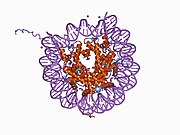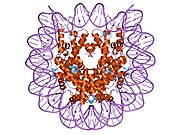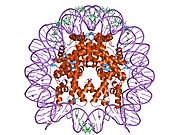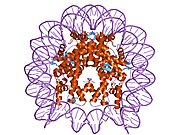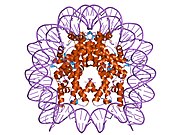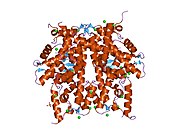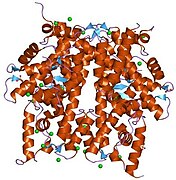| H2BU1 | |||||||||||||||||||||||||||||||||||||||||||||||||||
|---|---|---|---|---|---|---|---|---|---|---|---|---|---|---|---|---|---|---|---|---|---|---|---|---|---|---|---|---|---|---|---|---|---|---|---|---|---|---|---|---|---|---|---|---|---|---|---|---|---|---|---|
 | |||||||||||||||||||||||||||||||||||||||||||||||||||
| Identifiers | |||||||||||||||||||||||||||||||||||||||||||||||||||
| Aliases | H2BU1, H2Bb, histone cluster 3, H2bb, histone cluster 3 H2B family member b, H2B.U histone 1, HIST3H2BB | ||||||||||||||||||||||||||||||||||||||||||||||||||
| External IDs | OMIM: 615046; MGI: 1922442; HomoloGene: 75941; GeneCards: H2BU1; OMA:H2BU1 - orthologs | ||||||||||||||||||||||||||||||||||||||||||||||||||
| |||||||||||||||||||||||||||||||||||||||||||||||||||
| |||||||||||||||||||||||||||||||||||||||||||||||||||
| |||||||||||||||||||||||||||||||||||||||||||||||||||
| |||||||||||||||||||||||||||||||||||||||||||||||||||
| |||||||||||||||||||||||||||||||||||||||||||||||||||
| Wikidata | |||||||||||||||||||||||||||||||||||||||||||||||||||
| |||||||||||||||||||||||||||||||||||||||||||||||||||
Histone H2B type 3-B is a protein that in humans is encoded by the HIST3H2BB gene.
Histones are basic nuclear proteins that are responsible for the nucleosome structure of the chromosomal fiber in eukaryotes. Nucleosomes consist of approximately 146 base pairs (bp) of DNA wrapped around a histone octamer composed of pairs of each of the four core histones (H2A, H2B, H3, and H4). The chromatin fiber is further compacted through the interaction of a linker histone, H1, with the DNA between the nucleosomes to form higher order chromatin structures. This gene is intronless and encodes a member of the histone H2B family. Transcripts from this gene contain a palindromic termination element.
References
- ^ ENSG00000285449 GRCh38: Ensembl release 89: ENSG00000196890, ENSG00000285449 – Ensembl, May 2017
- ^ GRCm38: Ensembl release 89: ENSMUSG00000080712 – Ensembl, May 2017
- "Human PubMed Reference:". National Center for Biotechnology Information, U.S. National Library of Medicine.
- "Mouse PubMed Reference:". National Center for Biotechnology Information, U.S. National Library of Medicine.
- Marzluff WF, Gongidi P, Woods KR, Jin J, Maltais LJ (Oct 2002). "The human and mouse replication-dependent histone genes". Genomics. 80 (5): 487–98. doi:10.1016/S0888-7543(02)96850-3. PMID 12408966.
- ^ "Entrez Gene: HIST3H2BB histone cluster 3, H2bb".
Further reading
- Borowski P, Heiland M, Oehlmann K, et al. (1996). "Non-structural protein 3 of hepatitis C virus inhibits phosphorylation mediated by cAMP-dependent protein kinase". Eur. J. Biochem. 237 (3): 611–8. doi:10.1111/j.1432-1033.1996.0611p.x. PMID 8647104.
- El Kharroubi A, Piras G, Zensen R, Martin MA (1998). "Transcriptional activation of the integrated chromatin-associated human immunodeficiency virus type 1 promoter". Mol. Cell. Biol. 18 (5): 2535–44. doi:10.1128/mcb.18.5.2535. PMC 110633. PMID 9566873.
- Borowski P, Kühl R, Laufs R, et al. (1999). "Identification and characterization of a histone binding site of the non-structural protein 3 of hepatitis C virus". J. Clin. Virol. 13 (1–2): 61–9. doi:10.1016/S1386-6532(99)00007-4. PMID 10405893.
- Thomson S, Clayton AL, Hazzalin CA, et al. (1999). "The nucleosomal response associated with immediate-early gene induction is mediated via alternative MAP kinase cascades: MSK1 as a potential histone H3/HMG-14 kinase". EMBO J. 18 (17): 4779–93. doi:10.1093/emboj/18.17.4779. PMC 1171550. PMID 10469656.
- Deng L, de la Fuente C, Fu P, et al. (2001). "Acetylation of HIV-1 Tat by CBP/P300 increases transcription of integrated HIV-1 genome and enhances binding to core histones". Virology. 277 (2): 278–95. doi:10.1006/viro.2000.0593. PMID 11080476.
- Deng L, Wang D, de la Fuente C, et al. (2001). "Enhancement of the p300 HAT activity by HIV-1 Tat on chromatin DNA". Virology. 289 (2): 312–26. doi:10.1006/viro.2001.1129. PMID 11689053.
- Strausberg RL, Feingold EA, Grouse LH, et al. (2003). "Generation and initial analysis of more than 15,000 full-length human and mouse cDNA sequences". Proc. Natl. Acad. Sci. U.S.A. 99 (26): 16899–903. Bibcode:2002PNAS...9916899M. doi:10.1073/pnas.242603899. PMC 139241. PMID 12477932.
- Cheung WL, Ajiro K, Samejima K, et al. (2003). "Apoptotic phosphorylation of histone H2B is mediated by mammalian sterile twenty kinase". Cell. 113 (4): 507–17. doi:10.1016/S0092-8674(03)00355-6. PMID 12757711. S2CID 21854.
- Coleman MA, Miller KA, Beernink PT, et al. (2004). "Identification of chromatin-related protein interactions using protein microarrays". Proteomics. 3 (11): 2101–7. doi:10.1002/pmic.200300593. PMID 14595808. S2CID 23471253.
- Lusic M, Marcello A, Cereseto A, Giacca M (2004). "Regulation of HIV-1 gene expression by histone acetylation and factor recruitment at the LTR promoter". EMBO J. 22 (24): 6550–61. doi:10.1093/emboj/cdg631. PMC 291826. PMID 14657027.
- Ota T, Suzuki Y, Nishikawa T, et al. (2004). "Complete sequencing and characterization of 21,243 full-length human cDNAs". Nat. Genet. 36 (1): 40–5. doi:10.1038/ng1285. PMID 14702039.
- Kanno T, Kanno Y, Siegel RM, et al. (2004). "Selective recognition of acetylated histones by bromodomain proteins visualized in living cells". Mol. Cell. 13 (1): 33–43. doi:10.1016/S1097-2765(03)00482-9. PMID 14731392.
- Zhang Y, Griffin K, Mondal N, Parvin JD (2004). "Phosphorylation of histone H2A inhibits transcription on chromatin templates". J. Biol. Chem. 279 (21): 21866–72. doi:10.1074/jbc.M400099200. PMID 15010469.
- Gerhard DS, Wagner L, Feingold EA, et al. (2004). "The status, quality, and expansion of the NIH full-length cDNA project: the Mammalian Gene Collection (MGC)". Genome Res. 14 (10B): 2121–7. doi:10.1101/gr.2596504. PMC 528928. PMID 15489334.
- Golebiowski F, Kasprzak KS (2007). "Inhibition of core histones acetylation by carcinogenic nickel(II)". Mol. Cell. Biochem. 279 (1–2): 133–9. doi:10.1007/s11010-005-8285-1. PMID 16283522. S2CID 25071586.
- Zhu B, Zheng Y, Pham AD, et al. (2006). "Monoubiquitination of human histone H2B: the factors involved and their roles in HOX gene regulation". Mol. Cell. 20 (4): 601–11. doi:10.1016/j.molcel.2005.09.025. PMID 16307923.
- Bonenfant D, Coulot M, Towbin H, et al. (2006). "Characterization of histone H2A and H2B variants and their post-translational modifications by mass spectrometry". Mol. Cell. Proteomics. 5 (3): 541–52. doi:10.1074/mcp.M500288-MCP200. PMID 16319397.
- Beck HC, Nielsen EC, Matthiesen R, et al. (2006). "Quantitative proteomic analysis of post-translational modifications of human histones". Mol. Cell. Proteomics. 5 (7): 1314–25. doi:10.1074/mcp.M600007-MCP200. PMID 16627869.
- Gregory SG, Barlow KF, McLay KE, et al. (2006). "The DNA sequence and biological annotation of human chromosome 1". Nature. 441 (7091): 315–21. Bibcode:2006Natur.441..315G. doi:10.1038/nature04727. PMID 16710414.
This article on a gene on human chromosome 1 is a stub. You can help Misplaced Pages by expanding it. |







